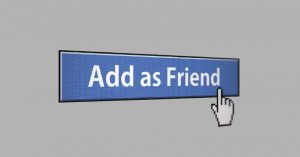
Nowadays social media is used by millions of people to connect with each other, some use it for professional communications, while some just want to connect and make new acquaintances. Even though there are several features on some social networking sites to keep your personal data private, other information are open
for others to obtain. Some people like to keep their account as an open book that gives out their personal information to random people, without thinking twice that it can be used by fraudsters. Some accounts get easily hacked because of this attitude, and since they don’t hide their personal data, it becomes easily accessible to hackers.
Social media isn’t limited to only Facebook, there are other platforms like Instagram, LinkedIn, Twitter, etc that run the risk of being hacked as well. How you ask? The most common mistake is when we accept random friend request. That’s right, accepting friend request from unknown people can double the probability of your account getting hacked.
Although, it is quite unlikely that you will be able to identify the offender, the least you can do is avoid them. There are some steps you can follow before accepting a random request on any social networks.
- Research comes in handy- It is always useful to do a quick Google search of an unknown person before accepting his or her request. You can either search for their name, or the profile picture in Google image search to make sure it’s the same person.
If you receive a connection request in LinkedIn, you can also search for them on other social networks to know if they are genuine or not. There are times when you will see in Facebook that a person has two or three accounts, you can either ask the person directly if they created all of them. Because most people who forget the password to their Facebook account tend to make another account without bothering to get hold of the one that already exists.
- Valuable connections- This is another procedure to follow before connecting with a particular person who is not known to you, and neither has any mutual connections. It is worth considering the fact whether the connection will be worthy to you professionally or even personally. There is nothing insensitive to look out for a possibility of gaining some benefit from a specific individual. For example, in LinkedIn most people prefer to make connections to random people who are hiring for better job opportunities and some are successful in it too.
- Selective choice works- If you don’t want to make acquaintance with a person who doesn’t serve any purpose to your career, or sometimes even your individual state, it is completely fine to decline the request. You might get some connection requests from people who are totally different from your line of work, it depends on you whether you want to connect to them or not.
- Overall purpose- Since most social networking sites are used by your friends, colleagues, contacts and other familiar people, you can use it to connect with them as per your requirement. The professional sites like LinkedIn is used to connect with hiring managers, as for the social platforms like Facebook and Instagram are a little different. You can share personal photos or even use it for to enhance your product appraisal by making pages related to your business. Find out which category suits your purpose. Example, it will definitely be helpful for your brand promotion if you accept every friend request.
- Fake accounts- It might get stressful to recognise a person’s genuine multiple accounts in Instagram, Facebook or Google, and the dilemma of whether to accept the request or not. So, instead of getting anxious you can directly talk to the person about his or her varied accounts. It can also be helpful to them to know that someone else might be making fake accounts in their name. You can even ask them questions that only both of you know the answer to for confirmation.
You can also follow these beneficial strategies to keep yourself safe from such scams.
More than one account
To pursue this method, first check through your friend list if there are multiple accounts of a person with similar name but different pictures. You can notify them about it. There will be some accounts without any profile picture but are active anyway, there profile pages have very few or no details at all. You can guess the red signal here.
Avoid getting hacked
If you want to keep your personal information safe, try to avoid having public account and use the platform’s security settings for keeping crucial data hidden. And if a social media platform doesn’t offer security control, better avoid using such sites.
Photos indicate fraud
That’s right. You can recognise an imposter by exploring through their album or even profile picture. Some people post pictures of famous actors, babies or dolls as their main photo, but if they genuine their albums will contain their original pictures. You can also double check to see if the photos are snapshots or professional photos. Don’t get lured by photos showing six-pack abs or beautiful girls.
CONCLUSION
There have been various instances of sexual harassment of women from esteemed corporate working men in LinkedIn who connect on the pretext of prospective job offers but end up sending vulgar messages to them. While in Facebook these occurrences are prevalent from a long time. Though the added feature of ‘Report’ in Facebook is a good initiative, it is better to avoid connecting with them at all.
Try to be safe and keep others safe by following the above methods. As long as the connection doesn’t serve any purpose, it is better to steer clear from them.
- RaaS : The Dark Side of SaaS
- Hackers Target MOVEit Transfer’s Zero-Day Vulnerability, Emergency Patch Deployed
- How Scammers Are Utilizing ChatGPT? Few Tips To Be Safe
- World Backup Day: Why Data Backups are Important in Cybersecurity
- What is Social Engineering and How Cyber Criminals Use It
- Things To Know About Personally Identifiable Information (PII)
- What is Data Breach? Why and How It occurs? How To Prevent Data Breach


